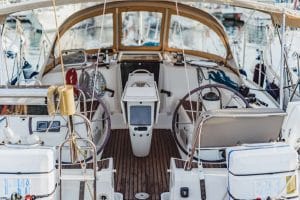Definitions
a) The word "whistle" means any device that is capable of producing the regulatory whistles and that complies with the specifications of Annex III of this Regulation.
b) The expression "short whistle" means a sound of a Approximate duration of one second.
c) The expression "long whistle" means a sound lasting approximately four to six seconds.
Acoustic signals: Equipment
a) Vessels of length equal to or greater than 12 meters will be equipped with a whistle and a bell, and ships of length equal to or greater than 100 meters will also carry a gong, whose tone and sound cannot be confused with that of the bell.
The whistle, bell and gong must comply with the specifications of Annex III of this Regulation. The bell or gong, or both, may be replaced by other equipment that has the same sound characteristics respectively, provided that always possible to manually make the prescribed sound signals.
b) Vessels length less than 12 meters will not be required to carry acoustic signaling devices prescribed in paragraph a) of this Rule, but if they do not have them, they must be equipped with other means to make the acoustic signals effective.
Maneuver and warning signs
a) When several vessels be in sight of each other, every ship of mechanical propulsion in navigation, when maneuvering in accordance with what is authorized or required by these Rules, You must indicate your maneuver through the following signals emitted with the whistle:
- A short blast to indicate: "I fall to starboard«;
- Two short blasts to indicate: "I fall to port«;
- Three short blasts to indicate: "I am giving back«.
b) Every ship may complement the whistles regulations of paragraph a) of this Rule through Light signals which will be repeated, depending on the circumstances, throughout the duration of the maneuver:
Yo. The meaning of these light signals will be the following:
- A flash: "I fall to starboard»;
- Two flashes: «I fall to port»;
- Three flashes: "I am giving back»;
ii. the duration of each flash will be approximately one second, he interval between flashes it will be about a second and the interval between successive signals shall not be less than 10 seconds;
iii. when the light used for these signals is carried it will be a white light all horizon visible at a minimum distance of 5 miles, and will comply with the specifications of Annex I of this Regulation
c) When two ships meet within sight of each other in a narrow passage or channel:
Yo. the ship who intends to reach the other must, in compliance with Rule 9 e) 1), indicate your intention by making the following signals with the whistle:
- Two long blasts followed by a short blast to indicate: «I intend to catch up with him through his band starboard.
- Two long blasts followed by two short blasts to indicate: «I intend to catch up with him through his band port.
ii. the ship that will be reached will indicate its agreement in compliance with Rule 9 e) I)
making the following signal with the whistle:
- A long whistle, a short one, a long one and a short one, in this order.
d) When several vessels within sight of each other approach, and for any reason any of them do not understand the actions or intentions of the other or have doubts about whether the other is carrying out the appropriate maneuver to avoid collision, The vessel in doubt shall immediately indicate that doubt by emitting at least five short and rapid whistles..
This signal may be complemented with a light signal of a minimum of five short, rapid flashes.
e) Vessels approaching a bend or area of a passage or channel where, due to their vision being obstructed, they cannot see other vessels, will sound a long whistle. This signal will be answered with a long blast by any approaching vessel which may be within acoustic range on the other side of the bend or behind the obstruction.
f) When the whistles are installed on a ship at a distance of more than 100 meters from each other, HE will only use one of the whistles to make signals maneuver and warning.
Are you interested in: Navigation lights and markings
Reduced visibility signal: Navigation beeps
In the close proximity or within an area of reduced visibility, either from day or night, the signals prescribed in this Rule will be made in the following manner:
a) A ship mechanical propulsion, with start, will issue a long whistle at intervals that No exceed 2 minutes.
b) A ship mechanical propulsion in navigation, but stopped and without starting, will broadcast at intervals not exceeding 2 minutes, two consecutive long blasts separated by an interval of about 2 seconds between them.
c) Ships no government or with his restricted maneuverability, ships restricted by their draft, ships sailing, ships dedicated to fishing and every ship dedicated to towing oa push to another vessel, shall emit three consecutive blasts at intervals not exceeding 2 minutes, namely, one long followed by two short, instead of the signs prescribed in paragraphs a) or b) of this Rule.
d) Dedicated vessels To fishing, when they are anchored, and the ships with restricted maneuverability that operate while at anchor, shall emit, instead of the signals prescribed in paragraph g), the signal prescribed in paragraph c) of this Rule.
e) A ship towed either, If more than one is towed, only the last one of the trailer, if manned, will emit four consecutive whistles at intervals not exceeding 2 minutes, namely, one long blast followed by three short blasts.
Where possible, this signal shall be made immediately after the signal made by the towing vessel.
f) When a ship that pushes and a ship that is pushed have a rigid connection so that they form a composite unit, they will be considered as a mechanically propelled vessel and they will make the signals prescribed in paragraphs a) or b) of this Rule.
g) A anchored ship will give a bell ringing of about 5 seconds duration at intervals not exceeding 1 minute. On a ship of length equal to more than 100 meters, the bell will be rung at the bow of the ship and, in addition, immediately after the bell ringing, the gong will be rung rapidly for about 5 seconds at the stern of the ship..
Every ship at anchor may also issue three consecutive whistles, namely, one short, one long and one short, to indicate its position and the possibility of boarding an approaching ship.
h) A stranded ship will issue the bell signal and, if necessary, the gong signal prescribed in paragraph g) of this Rule and, furthermore, it will give three clear and separate bell strokes immediately before and after the rapid ringing of the bell.
Every ship stranded may also emit an appropriate whistle signal.
i) A ship length less than 12 meters will not have the obligation to emit the signals
mentioned but, if you don't do them, shall emit another effective acoustic signal at intervals not exceeding 2 minutes.
j) One pilot boat, when on pilotage duty, may emit, in addition to the signals prescribed in paragraphs a), b) or g) of this Rule, an identification signal consisting of four short blasts.
Signs to attract attention
Any ship, if it needs to attract the attention of another, can do light or acoustic signals that cannot be confused with any of those authorized in any other of these rules, or direct the beam of your projector in the direction of the danger, doing so in a way that does not disturb other vessels. Any light used to attract the attention of another vessel shall be of such a nature that cannot be confused with any navigation aid.
For the purposes of this Rule, will avoid the use of flashing lights either high intensity rotating, like the lights strobe (light source that emits a series of very brief flashes in rapid succession and is used to produce multiple exposures of the phases of a movement).




